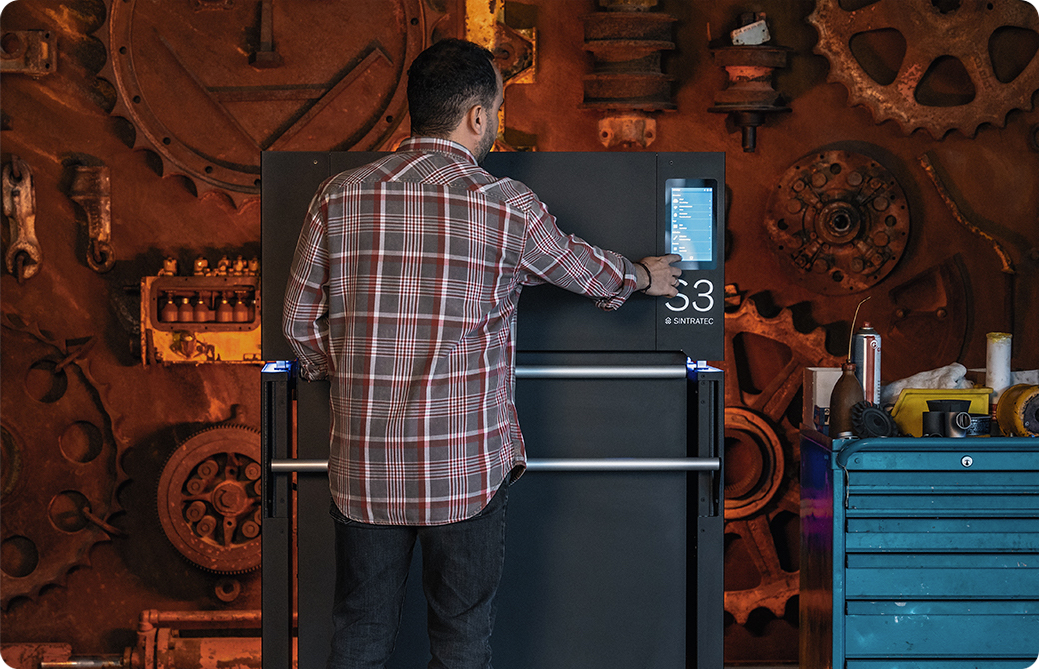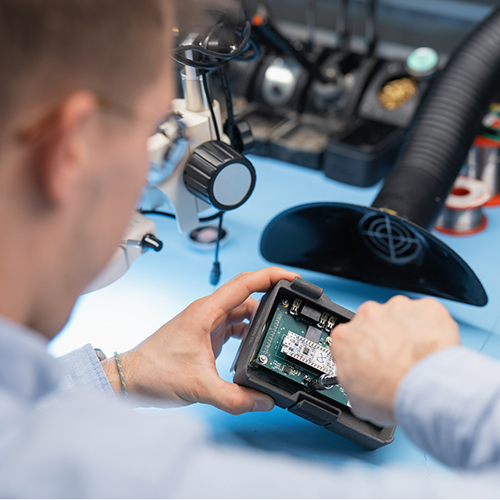Success with 3D printed race car parts
Swiss students from the Zurich University of Applied Sciences are building an electric racing car as part of the Formula Student competition. The team’s recipe for success includes 3D printed race car parts manufactured by Sintratec using the selective laser sintering process.
Swiss team steps on the gas
At the Zurich University of Applied Sciences ZHAW in Winterthur, Moreno Apicella welcomes us and leads us into a workshop. In addition to his master’s degree, the mechanical engineering student is the team leader of Zurich UAS Racing. The goal of the project: to build an electric race car within one year and to qualify for at least three Formula Student events in Europe. To achieve this, the budding engineer can draw on a wide range of expertise: «We currently have about 65 members – mostly from the technical field, but also from business and economic studies», says Apicella. The young team aims to improve on the results of previous years for its fourth participation in 2024.


Around 65 ZHAW students are developing an electric racing car within a year.
Hands-on experience on the race track
The Formula Student events are the largest international engineering competitions in which students from all over the world compete against each other in various categories. Using their self-developed race cars, the challenge is to prevail against other university teams in dynamic and static disciplines such as engineering, performance, finance, and aesthetics. «What makes the competition unique for me is the hands-on experience it offers students in applying theoretical knowledge to real-world engineering challenges,» Apicella states. Additionally, working closely with industry professionals also provides the team with an important exchange and insight into possible future careers.
Diverse manufacturing technologies
In the workshop at the University of Applied Sciences stand the racing cars from the last two years and this year’s model, which still consists of a tubular frame with wheel carriers. The students have until the rollout in May to complete the car before the events begin in July. Due to the tight timeline and budget, Apicella and his fellow students are also relying on additive manufacturing technologies to create their vehicle. «3D printing is essential for our team because it allows us to prototype quickly and customize complex parts with high precision», explains the mechanical engineering student. The freedom of design in particular is essential for optimizing the electric car.
Based on the previous model, the UAS Racing Team is building its 2024 race car.
Components from the 3D Printer
The team uses a variety of 3D printing processes, such as Fused Deposition Modeling (FDM) for the laminating molds of the aerodynamic package. However, for parts that go directly into the car, more sophisticated technologies are required: «Our requirements for 3D printed race car parts are a good strength-to-weight ratio and excellent mechanical properties, such as waterproof components», says Apicella. FDM quickly reaches its limits, so the students turn to selective laser sintering (SLS). As part of a sponsorship, several pieces were produced by Sintratec, a Swiss manufacturer of SLS 3D printers.



The steering wheel was ergonomically designed and 3D printed based on a hand scan of the driver.
An ergonomic steering wheel
A concrete example of the use of SLS is the steering wheel. It was clear from the beginning that additive technologies would be used. «We took a handprint of our driver and 3D scanned it», Apicella describes. «Based on that, we were able to ergonomically design the steering wheel to fit his hands perfectly.» After completion of the CAD model, the part was 3D printed on the Sintratec S3 using robust PA12 nylon, and then built in the car along with the electronics. As this is a customized one-off, traditional manufacturing would not only have been much more expensive, but also could not have provided the same level of customization.
Waterproof cooling jackets
Another 3D printed element of the race car is the cooling jacket. This critical component of the drivetrain directs coolant to the four engines to regulate their temperature. Here, Apicella’s team was able to take full advantage of the design freedom of SLS 3D printing: «We have integrated quite a complex structure in our cooling jacket, especially the inner side», the student explains. «This geometry is practically impossible to manufacture using machining processes, which is why we chose SLS.» As the Formula Student regulation states that no liquid can leak from the car, the waterproof properties of the PA12 material are also crucial for this application.
The PA12 cooling jacket is designed, assembled, and built into the vehicle.
Potential for the Automotive Industry
Advanced manufacturing technologies such as selective laser sintering are already an integral part of modern vehicle development and production. For the UAS Racing Team, the added value is obvious. «I see the main advantage of SLS for the automotive industry and for our project in the high design flexibility and speed», emphasizes Apicella. «This makes the technology well suited for the lightweight structural components, custom fixtures, and spare parts, ultimately contributing to improved vehicle performance and efficiency.» In Winterthur, the team is confident that the SLS 3D prints will prove themselves in the endurance test on the race track.



Successful Swiss Collaboration
Sintratec has supported Formula Student projects with 3D printed race car parts in the past, but none from Switzerland so far. In the case of the Zurich UAS Racing Team, the geographical proximity made the collaboration all the more obvious and straightforward. «The cooperation with Sintratec was highly satisfactory», Moreno Apicella concludes. «We had excellent technical support and, with SLS, had the best material and process that fulfilled our requirements and helped to optimize the performance of our car.» For the student, it is evident that this 3D printing technology will also play a key role in future projects for a wide range of applications.

“We use SLS technology for 3D printed race car parts because of the design freedom and excellent mechanical properties.”
Moreno Apicella
Team Manager
Zurich UAS Racing Team
Need consulting?
Our team is happy to advise you and to begin your journey into the world of SLS. Contact us right away!

[contact-form-7 id=”32022″ title=”Contact form Story”]




